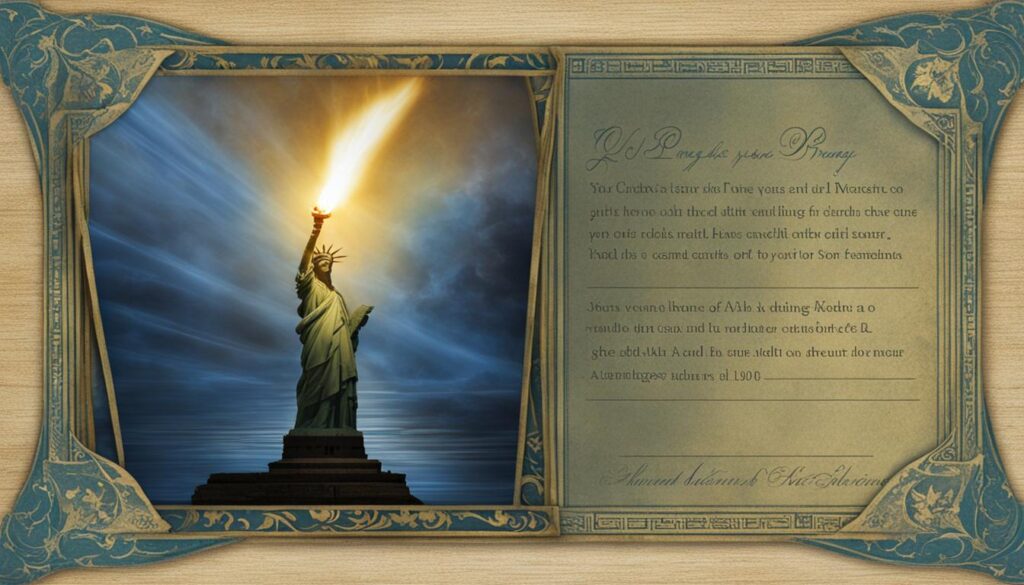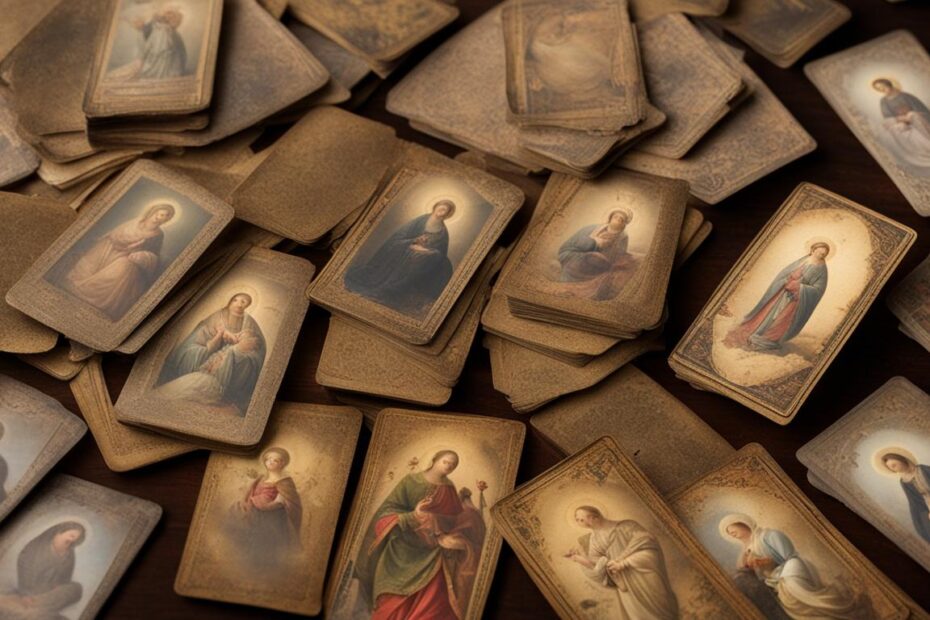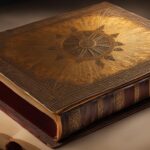The origins of prayer cards can be traced back to the 15th century when they played a fundamental role in the spread of Christianity. During a time when the majority of people were illiterate, prayer cards provided a visual representation of sacred objects and saints, along with accompanying prayers or hagiographic texts.
The early versions of prayer cards were created by miniaturists who embellished sacred texts with initial letters that depicted images of Jesus, the Virgin Mary, or saints. The demand for prayer cards grew, leading to the development of printing techniques such as woodcut, burin engraving, etching, and canivet.
The mass production of prayer cards started in the late 1700s, and lithography became a popular method in the 19th century. Today, prayer cards are still cherished as collectible religious memorabilia.
Key Takeaways:
- Prayer cards originated in the 15th century and played a vital role in spreading Christianity.
- They provided a visual representation of sacred objects and saints for the illiterate.
- Printing techniques like woodcut, engraving, and lithography were used to produce prayer cards.
- Prayer cards are still valued as collectible religious memorabilia today.
The Significance of Prayer Cards
Prayer cards hold significant historical and cultural importance, serving as visual aids for spreading religious teachings and devotion to the masses. In the early days, when literacy was limited, prayer cards provided a means of connection to sacred objects and saints through their visual representations accompanied by prayers or hagiographic texts. The evolution of prayer cards from hand-painted miniatures to printed reproductions played a vital role in widening their dissemination and accessibility.
Antique prayer cards carry sentimental value and are treasured as tangible connections to the past. They serve as reminders of individuals’ personal spiritual journeys and acts of devotion. The historical and artistic significance of prayer cards has also made them highly sought after by collectors, placing them within the realm of religious card memorabilia.
“Prayer cards have withstood the test of time and continue to hold significance in our increasingly secular world. They provide a physical and tangible representation of one’s faith, serving as a source of comfort, inspiration, and reflection.” – Religious Art Collector
The Evolution of Prayer Cards
The evolution of prayer cards reflects advancements in printing techniques over time. From the early days of woodcut and burin engraving to the popularity of lithography in the 19th century, prayer cards have adapted to meet the needs and aesthetics of different eras. Today, prayer card production incorporates modern technologies, such as digital printing and advanced printing methods, to create more detailed and refined images on prayer cards.
Antique Prayer Cards as Treasured Artifacts
Antique prayer cards are not only valued for their religious significance but also for their historical and artistic value. They provide insights into the artistic styles and cultural trends of different periods. The intricate designs, vibrant colors, and embellishments found on antique prayer cards showcase the artistry and craftsmanship of the past, making them highly sought after by collectors and enthusiasts.
| Period | Main Characteristics |
|---|---|
| 15th Century | Hand-painted miniatures by skilled miniaturists |
| 19th Century | Introduction of lithography, allowing for mass production |
| Art Déco and Liberty Movements | Elaborate decorations, vibrant colors, intricate designs |
| Counter-Reformation Period | Canivets with ornamental crochet-like technique, incorporating fabrics, pearls, golden and silver threads, ribbons, and various embellishments |
As we explore the rich history of prayer cards, it becomes apparent that they are not just simple pieces of paper, but rather powerful artifacts that have played a significant role in preserving religious traditions and spreading devotion throughout centuries of human history.
Prayer Card Traditions and Production
Prayer cards have a rich history within various religious traditions and ceremonies. They are often distributed during significant events such as baptisms, First Communions, confirmations, weddings, and funerals. These cards serve as tangible reminders of important religious milestones and are cherished keepsakes. Moreover, prayer cards have also been used as personal devotional tools, allowing individuals to carry a symbol of their faith with them and providing a source of comfort and reflection in moments of prayer.
The production of prayer cards has evolved over time, with different techniques and materials being utilized. The early prayer cards were created using methods like woodcut and engravings, where skilled artisans meticulously crafted intricate designs. As printing techniques developed, lithography became a popular method in the 19th century, allowing for mass production and wider accessibility of prayer cards. Specialized publishing houses emerged, producing prayer cards for various occasions and religious themes, catering to the needs of a diverse audience.
It’s worth noting that the production of prayer cards is often guided by religious practices and teachings. The Church has implemented an approval system to ensure the authenticity and adherence to religious principles. Prayer cards bearing the official seal of “Imprimatur” indicate that they have undergone this approval process, providing reassurance to believers that the content and imagery are in line with the teachings of the Church.
| Table: Evolution of Prayer Card Production Techniques | |
|---|---|
| 15th century | Miniaturists create prayer cards with hand-painted images |
| Late 1700s | Mass production begins with woodcut and engravings |
| 19th century | Lithography becomes a popular method |
| Present day | Advanced printing technologies such as digital printing are used |
Liberty Prayer Cards and Laced Prayer Cards
Two unique variations within the prayer card tradition are Liberty prayer cards and Laced prayer cards. These distinctive styles showcase the artistry and creativity that have evolved over time.
Liberty Prayer Cards: A Celebration of Artistic Aesthetics
During the Art Déco and Liberty movements, Liberty prayer cards emerged as vibrant and elaborate expressions of faith. These cards featured intricate decorations such as garlands, symbols, ribbons, and embossed images. The Art Déco style, known for its geometric shapes and bold colors, influenced the design of these prayer cards, resulting in visually striking pieces of religious art. Liberty prayer cards are highly sought after by collectors, not only for their religious significance but also for their representation of the artistic aesthetics of a particular era.
Laced Prayer Cards: Exquisite Delicacy in Design
Laced prayer cards are characterized by delicate engravings surrounding an oval in the middle, which gracefully houses a sacred image. These prayer cards showcase a level of intricacy and attention to detail that reflects the devotion and craftsmanship of the artists who created them. Laced prayer cards were particularly popular during the Counter-Reformation period when ornamental crochet-like techniques, known as canivets, were used to create these exquisite works. Canivets incorporated fabrics, pearls, golden and silver threads, ribbons, and various embellishments, resulting in elaborate collage-like prayer cards that were highly treasured.
Both Liberty prayer cards and Laced prayer cards represent the evolution of prayer card design and production. They exemplify the diverse artistic expressions and cultural influences that have shaped the history of prayer cards throughout the centuries. Whether it’s the bold colors and elaborate decorations of Liberty prayer cards or the delicate engravings and ornamental techniques of Laced prayer cards, these unique variations continue to captivate collectors and enthusiasts, showcasing the enduring power of faith and artistry.

| Feature | Liberty Prayer Cards | Laced Prayer Cards |
|---|---|---|
| Design Style | Art Déco and Liberty movement-inspired | Engravings with delicate lace-like details |
| Decorations | Elaborate garlands, symbols, ribbons, and embossed images | Ornamental engravings surrounding a central oval |
| Materials Used | Paper, ink, and various printing techniques | Fabric, pearls, golden and silver threads, ribbons, and embellishments |
| Influence | Art Déco and Liberty movements | Counter-Reformation period and ornamental crochet techniques |
| Collectibility | Highly sought after by collectors due to their artistic aesthetics | Treasured for their delicate engravings and elaborate design |
Today’s Prayer Cards
The production of prayer cards has embraced modern techniques while still honoring traditional craftsmanship. Woodcut and engravings, once the primary methods, have now been complemented by newer materials like linoleum sheets to streamline the production process. Advanced printing technologies such as lithography and digital printing have also revolutionized the design and quality of prayer cards.
Modern prayer cards showcase intricate details and vibrant colors, capturing the essence of religious symbolism. These cards are available for various religious occasions and can be customized to commemorate special events or individuals. Personalized prayer cards add a personal touch and serve as cherished keepsakes for individuals or families.
For collectors and enthusiasts, vintage and antique prayer cards continue to hold great value. These cards capture the historical evolution of prayer cards and are sought after for their artistic appeal and historical significance. They offer a glimpse into the past and provide a tangible connection to the rich history of faith and spirituality.
The Value of Modern Prayer Cards
In today’s digital age, the continued production and popularity of prayer cards speak to their enduring significance. Despite advancements in technology, prayer cards remain a cherished expression of devotion and a way to connect with one’s faith. Whether used for daily prayers, distributed during religious ceremonies, or collected as meaningful artifacts, prayer cards continue to play a vital role in religious traditions and personal spiritual journeys.
| Prayer Card Features | Benefits |
|---|---|
| Customization | Personalized designs for special occasions |
| Advanced Printing Techniques | High-quality reproductions with intricate details |
| Artistic Appeal | Vibrant colors and captivating designs |
| Historical Significance | Collectible vintage and antique prayer cards |
In conclusion, modern prayer cards continue to honor the heritage of their historical counterparts while embracing new techniques and designs. They serve as tangible reminders of faith, offering comfort, inspiration, and a connection to the divine. Whether preserved as collectibles, utilized for personal devotion, or shared in religious ceremonies, prayer cards hold a special place in the hearts of believers and collectors alike.
Conclusion
Prayer cards have a rich and fascinating history that spans centuries. They have played a vital role in spreading religious teachings and devotion, especially during times of limited literacy. From hand-painted miniatures to printed reproductions, the evolution of prayer cards has allowed for wider accessibility and dissemination.
Today, prayer cards continue to hold significant cultural and historical importance. They serve as tangible connections to the past, reminding individuals of their personal spiritual journeys and acts of devotion. Collectors value prayer cards for their artistic and historical significance, making them highly sought-after within the realm of religious card memorabilia.
The production of prayer cards has advanced with the introduction of modern technologies while preserving traditional artistry. From woodcut and engravings to advanced printing methods, prayer cards now feature more detailed and refined images. They are available for various religious occasions, and personalized prayer cards can be created to commemorate special events and individuals. Vintage and antique prayer cards remain highly cherished by collectors and enthusiasts alike.
Whether used for personal devotion or collected as historical artifacts, prayer cards continue to play an integral role in the lives of individuals and communities, providing a tangible connection to faith, spirituality, and the rich history of religious traditions.
FAQ
What is the history of prayer cards?
Prayer cards have their origins in the 15th century and played a crucial role in spreading Christianity during a time when many people were illiterate.
How were prayer cards initially created?
Miniaturists created the early versions of prayer cards by embellishing sacred texts with initial letters depicting images of Jesus, the Virgin Mary, or saints.
When did the mass production of prayer cards begin?
Prayer cards began to be mass-produced in the late 1700s, with lithography becoming a popular method in the 19th century.
What is the significance of antique prayer cards?
Antique prayer cards hold sentimental value and serve as tangible connections to the past, reminding individuals of their spiritual journeys and acts of devotion.
When are prayer cards commonly distributed?
Prayer cards are commonly distributed during significant religious events such as baptisms, First Communions, confirmations, weddings, and funerals.
What are Liberty Prayer Cards and Laced Prayer Cards?
Liberty Prayer Cards were popular during the Art Déco and Liberty movements, featuring elaborate decorations and vibrant colors. Laced Prayer Cards featured delicate engravings surrounding a sacred image in the center.
What materials and techniques are used in prayer card production today?
Traditional techniques like woodcut and engraving are still practiced, but newer methods like linoleum sheets and advanced printing technologies such as lithography and digital printing are also used.
Are personalized prayer cards available?
Yes, personalized prayer cards can be created to commemorate special events or individuals.
Are vintage and antique prayer cards sought after?
Yes, vintage and antique prayer cards remain highly sought after by collectors and enthusiasts.








